|
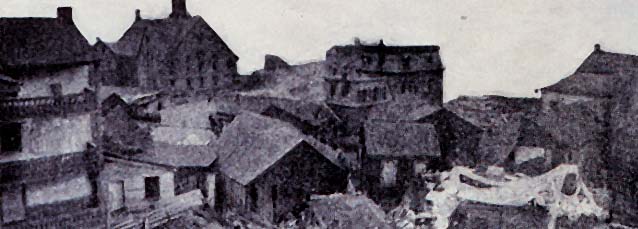 |
| NOAA Photo Library - Homes
Destroyed by the Storm Surge - Galveston, TX 1900 |
 On
September 8, 1900, a killer category 4 hurricane struck the Texas
coastal city of Galveston. This hurricane would become the greatest
natural disaster, by number of deaths, in United States history: 8,000
by accepted figures, perhaps as many as 12,000. Of that total, 6,000
perished in Galveston alone. The tragedy killed more Americans than
any other natural disaster, indeed, more than the legendary Johnstown
Flood, the San Francisco Earthquake, the 1938 New England Hurricane
and the Great Chicago Fire combined. On
September 8, 1900, a killer category 4 hurricane struck the Texas
coastal city of Galveston. This hurricane would become the greatest
natural disaster, by number of deaths, in United States history: 8,000
by accepted figures, perhaps as many as 12,000. Of that total, 6,000
perished in Galveston alone. The tragedy killed more Americans than
any other natural disaster, indeed, more than the legendary Johnstown
Flood, the San Francisco Earthquake, the 1938 New England Hurricane
and the Great Chicago Fire combined.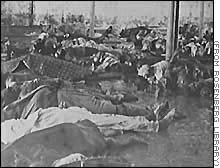
The deadliest natural disaster in U.S. history ripped into the
"Wall street of the South" killing some 8,000 men, women and children
and wiping away 12 city blocks -- nearly three-quarters of the island
city of Galveston, Texas.
Linda MacDonald, whose late grandfather lived through the Great
Storm, remembers the stories he told of how, as a six-year-old boy, he
rode out the tempest in his father's bakery as winds howled and waves
crashed. "He could hear children calling for their mothers, women
screaming for help and men begging for mercy from God," said
MacDonald, a Galveston native and an amateur expert on the storm. "He
said he could hear sounds that were very faint, then they grew louder
and louder, then the sound abruptly cut off, and he knew someone's
life had ended."
However the killer storm did not come without warning. Days before
the hurricane reached Texas, telegraph reports received in Galveston
told of the havoc the storm caused in the Caribbean. Sailors arrived
in port talking of the stormy seas.
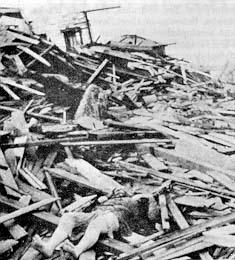 "People
in Galveston knew that there was a storm in the Gulf of Mexico. It was
reported in the Galveston County Daily News but they didn't know where
the storm would make landfall," said historian Casey Greene. Some
historians say people's attitude increased the number of fatalities. "People
in Galveston knew that there was a storm in the Gulf of Mexico. It was
reported in the Galveston County Daily News but they didn't know where
the storm would make landfall," said historian Casey Greene. Some
historians say people's attitude increased the number of fatalities.
"That's one of the reasons so many people lost their lives:
complacency," said Greene.
In 1900, Galveston was stuck on itself, boasting Texas' first post
office, telephones, and medical college. There was more money in
Galveston than in Newport, Rhode Island.
Downtown was packed with ornate office buildings, many on The
Strand, known then as the "Wall Street of the Southwest." Galveston
was the hub of a booming cotton export trade because it had the only
deep-water port in Texas at the time. City streets led to imposing
Greek Revival, Romanesque and Italianate mansions. Street cars ran
along the beach. Bathhouses jutted out like sentinels in the gulf.
"There was this great sense of hubris that America and Galveston --
Galveston in particular --was going places, could do no wrong," said
Erik Larson, author of "Isaac's Storm."
Isacc Cline
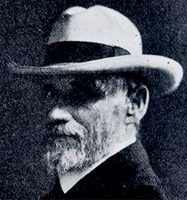 Isaac
was U.S. Weather Bureau climatologist Isaac Cline, who dismissed as
absurd the notion that a hurricane could devastate Galveston. His
stance discouraged the town from building a sea wall. The day before
the hurricane arrived, warning flags were raised as huge waves pounded
the shores, barometric pressure dropped rapidly and high
fish-scale-shaped clouds moved inland. Isaac
was U.S. Weather Bureau climatologist Isaac Cline, who dismissed as
absurd the notion that a hurricane could devastate Galveston. His
stance discouraged the town from building a sea wall. The day before
the hurricane arrived, warning flags were raised as huge waves pounded
the shores, barometric pressure dropped rapidly and high
fish-scale-shaped clouds moved inland.
Before dawn September 8, the water crept ashore and kept rising,
despite strengthening north winds that should have repelled the storm.
By now, Cline was worried. "Unusually heavy swells from the southeast.
... Such high water with opposing winds never observed previously," he
wrote in a telegram to the bureau's headquarters in Washington. But
less than half the population evacuated the island and some sightseers
even came over from Houston to view the spectacle of the huge and
powerful surf.
Cline rode down the beach in a horse-drawn buggy, warning people to
get to the mainland. But for most, it was too late. A steamship broke
free of its moorings and destroyed three bridges to the mainland. As
people fled to higher ground, waves raged inward from both the gulf
and the bay. Homes disintegrated and rushing waters swept people away.
Cline's aides measured speeds of 100 mph before their anemometer was
blown away, and the wind would eventually peak at 150 mph.
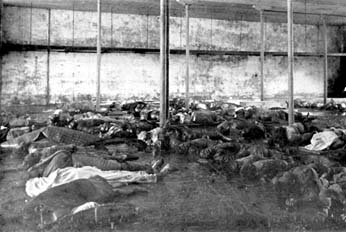
"The roofs of the houses and timbers were flying through the
streets as though they were paper and it appeared suicidal to attempt
a journey through the flying timbers," Cline wrote later that month in
a report to his superiors. St. Mary's Orphanage, home to 93 children
and 10 Catholic nuns, stood near the beach and was one of the first
buildings to succumb to the storm. The only survivors were three boys
who managed to cling to an uprooted tree as it was tossed around by
the rising waters.
Water continued to rise until the whole island was submerged by 3
p.m. and by midnight waves 15 high tore buildings apart with
contemptuous ease. Cline's own home, battered by the waves and heavy
debris, eventually collapsed.
"My residence went down with about 50 persons who had sought it out
for safety and all but 18 were hurled into eternity. Among the lost
was my wife who never rose above the water after the wreck of the
building," Cline wrote in his report. Almost a month would pass before
Cora May Cline's body was found among the mounds of debris that
littered the city.
Cline himself nearly drowned but recovered and found himself
clinging to his youngest child. His brother Joseph had grabbed Cline's
other two children and they managed to keep afloat for three hours on
wreckage until the worst of the storm had passed. Rich and poor alike
huddled together in ornate mansions such as "Bishop's Palace." Still
standing today, its strong walls saved the lives of some 200 people.
Others had desperately clung to life.
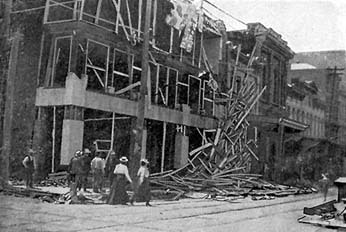 "Some
of them were on rooftops. some of them were in trees, some of them
were hanging on to logs and stuff in the water," Maybelle Doolin
remembers from her family's history. "Some
of them were on rooftops. some of them were in trees, some of them
were hanging on to logs and stuff in the water," Maybelle Doolin
remembers from her family's history.
Doolin's father and his three step brothers spent hours in a row
boat pulling people from the debris filled water; they are credited
with saving 200 lives.
Historians don't know exactly how many people perished, but they
believe it could have been as many as 10,000. Nearly everyone lost
family and friends.
After the storm's fury had passed and the water receded, survivors
stared in disbelief at human and animal corpses strewn among piles of
smashed timber and masonry.
There were too many dead to bury, so the remains were initially
weighted down and dropped into the Gulf of Mexico. But the bodies
floated back to shore and were eventually burned in funeral pyres.
"If you can imagine walking out your back door -- and where you
ordinarily see somebody's yard, kids playing and houses and the
streets and all that stuff -- what you would most likely have seen is
a pile in which your neighbors where at that very moment being
incinerated," said Erick Larson.
Human remains were found as late as February of 1901.
Sea Wall
Months after the hurricane, Galveston started construction on a
17-foot-high, 3-mile-long sea wall. Phase one of the project cost $1.6
million dollars, an astronomical amount at the time.
Civil engineers also raised Galveston's elevation, the highest
point of which before the storm was less than nine feet above sea
level. Thousands of homes and buildings were propped up so earth could
be filled in underneath, a method that raised some structures as high
as 17 feet.
Galveston is a city built on sand at the eastern end of a
30-mile-long island, two miles off the Texas coast. It remains
vulnerable today despite the sea wall.
Constant vigilance is maintained during the June-November hurricane
season because it would take more than 40 hours to evacuate the 65,000
people to the mainland.
Anyone who failed to heed a call to evacuate would be at the
storm's mercy because the causeway to the mainland is closed when
winds reach tropical storm strength of 39 mph.
"We have a name for people like that. We call them statistics.
There's nothing that important to risk your life for," said city
emergency management chief William Zagorski.
While Galveston succeeded in rebuilding after the storm, it would
never regain its former prominence as one of the wealthiest
communities in the nation. As a major Texas city, it was soon
overshadowed by the emergence of nearby Houston as a center for the
Texas oil industry and as a major port following the completion in
1914 of a ship channel that linked it directly to the Gulf of Mexico.
To Read More
About the Storm Click Here - A More in Depth History an Accounting
|
